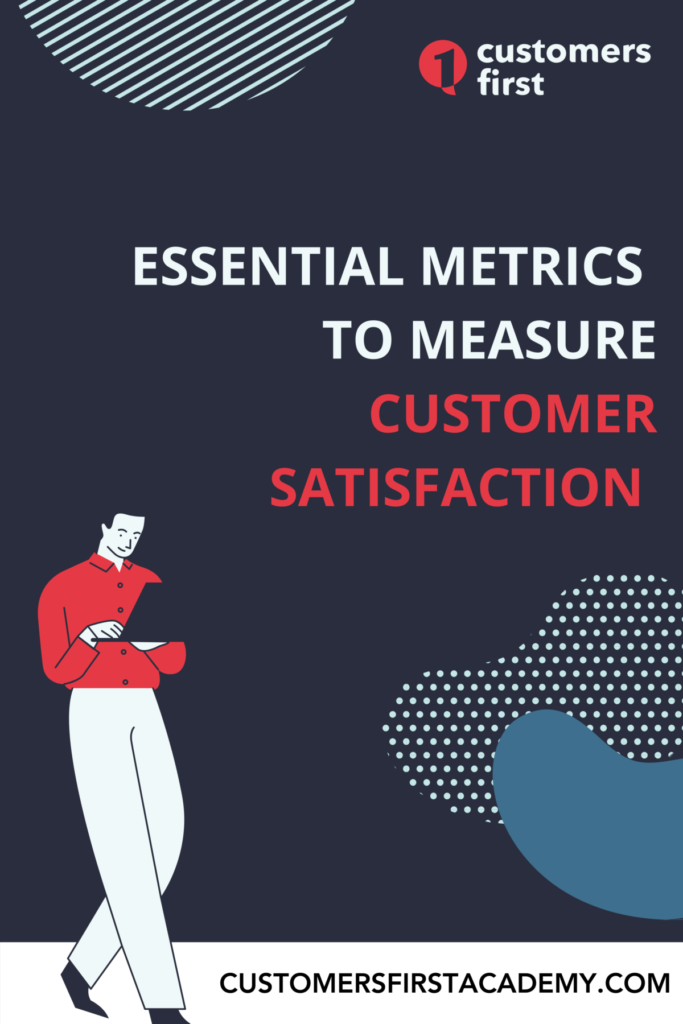What Types of Metrics Measure Customer Satisfaction?
Wondering what types of metrics measure customer satisfaction? Congratulations, that question shows that you deeply care about your customers. See, just stating on your online values page that you care about your customer is not a mark of being customer-centric. What truly demonstrates your commitment to customer-centricity is your desire to measure certain metrics.

It’s the willingness to put certain things to the test that sets successful businesses apart. Measuring something means it will get monitored and when it gets monitored there is a potential of it getting improved. So, the desire to measure customer satisfaction shows a commitment to putting the focus on customers, and that’s what business success is all about these days.
Measuring customer satisfaction is a good way to gauge the customer-centricity of your organization. This is because, when you focus on customers, you increase customer loyalty and in effect decrease customer churn. Measuring customer satisfaction also shows you the efficacy of your marketing. Your marketing messages set customer expectations and customer satisfaction means that those expectations are being met.
So, what types of metrics measure customer satisfaction? Here they are:
#1: Customer Satisfaction Score (CSAT)
This is a straightforward and efficient way to track customer satisfaction. The CSAT revolves around asking the customer a simple question i.e. “On a scale of 1-10 how satisfied are you with the service?” The scale may be varied to be from 1-3, 1-5, or 1-10 but the manner of interpreting remains the same.
Lower scores of 1-2 on a scale of 1-5 reflect dissatisfaction and higher scores like 4-5 will reflect satisfaction. Sometimes in place of numbers as scores, emojis are used to reflect emotion to transcend language barriers. The question is posed right after the interaction that is being tracked as the customer’s emotions are vivid in the customer’s mind.

The CSAT score is then worked out by taking the number of “satisfied” or “very satisfied” customers and dividing them by the total number of respondents. One limitation of the CSAT is that it offers a simplistic measure as neutral or dissatisfied customers are less likely to participate anyway. However, one benefit of CSAT is that it gives an insight into how happy the employees are as well since it’s directly related to the employee’s satisfaction level.
#2: Net Promoter Score (NPS)
This is another powerful metric for measuring customer loyalty. It was introduced in 2003 by Fred Reichheld, a partner at Bain & Company. The NPS goes a step beyond the CSAT. The NPS moves from inquiring about the customer’s emotion (as in CSAT) to intent. If the CSAT focuses on how satisfied the customer felt after an interaction, the NPS focuses on the question of “how likely a customer is to recommend your services or products to a friend”.
The customer answers the question on a scale of 1-10 and based on the responses the customers are classified into three categories. Customer who responded in the 9-10 range are known as “promoters”, 7-8 range are grouped as “passive”, and below 7 raters are “detractors”.
Promoters are the customers that were truly satisfied with your services or products and are now your brand advocates. The detractors are so unhappy that they are likely to spread the bad word about your brand and the passive customers are likely to do neither.
The NPS is an effective metric as its correlation to business growth has been demonstrated time and again. It has been adopted and tested by many big companies and businesses that were looking to scale up. In fact, the implications of adopting the NPS are considered so significant that the acronym NPS has been expanded and called the Net Promoter System.

#3: Customer Effort Score (CES)
The customer effort score metric revolves around the idea that customers want to spend the least amount of effort while getting their problems resolved. So, even though the question may be phrased in many different ways, the intent is to gauge how difficult or easy it was for a customer to get their needs met from your service or brand. Customer experience management software can help you track and analyze these essential metrics to improve your customer service strategy.

The respondents are given a scale of 1-5 or 1-7 with low scores indicating some version of “very difficult” and “difficult” rating and higher scores meaning “very easy” and “easy”. An average is drawn out to see where the service stands with regards to ease of resolving customer’s problems.
The data for this metric is also gathered right after a customer interaction and it is one of the most highly correlated metrics to customer loyalty. In the Harvard Business Review study titled “Stop trying to delight your customers” the CES outperformed the CSAT and NPS when it came to predicting customer loyalty.
#4: Customer Feedback and Reviews
While thinking about what types of metrics measure customer satisfaction it is easy to forget the most obvious ways in which customers express themselves. Tracking metrics, collecting data, and figures is a dependable way of measuring the success of your business with respect to customer interactions. Still, the importance of direct customer feedback and online reviews can not be overstated. Firstly, customer reviews add social proof, so, good reviews and ratings mean more sales and increased revenue.
Secondly, the CSAT or the NPS will give you a measure of whether the customer is happy or not however, the online reviews will tell you why the customer is happy or not. In this manner, customer feedback and reviews offer a lot of insight into what is specifically working or not working for customers. The subjectively written feedback and reviews are a goldmine for any organization truly looking for what makes its customers tick.
Brief Summary:
- Wondering what types of metrics measure customer satisfaction is a key indicator that you are customer-oriented.
- Customer satisfaction metrics can help you find out how customer-centric your business is, increase customer loyalty, improve marketing messages and increase revenue.
- Customer satisfaction score (CSAT) involves asking your customer how satisfied they are with your product or service.
- Net promoter score (NPS) involves finding how likely, on a scale of 1-10, is a customer to recommend your product or services to family or friends.
- The customer effort score (CES) aims to find out how much effort the customer had to exert in getting his problem resolved. The CES is much more effective in predicting customer loyalty than the CSAT or NPS.
- Customer feedback and reviews can give you an insight into what subjectively clicks for your customers.
Other Resources:
CustomersFirst Academy offers comprehensive customer service training designed to help you grow your skills and advance your career.
To keep learning and developing your knowledge of customer service, we highly recommend the additional resources below:
7 Effective Strategies to Improve Medical Customer Service
Improve Group Communication Using Email
Business Strategy Guide to Customer Intimacy
What Is a Customer Service Advocate and How to Become One?

